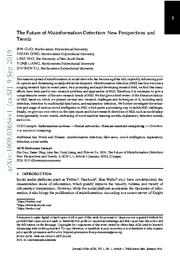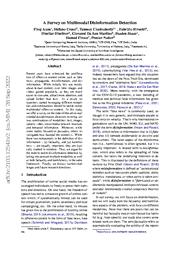A copy of this work was available on the public web and has been preserved in the Wayback Machine. The capture dates from 2020; you can also visit the original URL.
The file type is application/pdf.
Filters
Detecting Fake News with Weak Social Supervision
[article]
2020
arXiv
pre-print
Specifically, we use the recent research on fake news detection as the use case, where social engagements are abundant but annotated examples are scarce, to show that weak social supervision is effective ...
Social media has little labeled data but possesses unique characteristics that make it suitable for generating weak supervision, resulting in a new type of weak supervision, i.e., weak social supervision ...
Weak Social Supervision for Fake News Detection Most of the current methods are trying to exploit weak social supervision as constraints to help fake news detection. ...
arXiv:1910.11430v2
fatcat:exg7qtees5fj3g3bvk7d2qb6ge
Leveraging Multi-Source Weak Social Supervision for Early Detection of Fake News
[article]
2020
arXiv
pre-print
Experiments on realworld datasets demonstrate that the proposed framework outperforms state-of-the-art baselines for early detection of fake news without using any user engagements at prediction time. ...
In this work, we exploit multiple weak signals from different sources given by user and content engagements (referred to as weak social supervision), and their complementary utilities to detect fake news ...
Models include the following state-of-the-art early fake news detection methods: -TCNN-URG [19] : This method exploits users' historical comments on news articles to learn to generate synthetic user comments ...
arXiv:2004.01732v1
fatcat:djfuown67zbxpcjygi7mv2rqde
MALCOM: Generating Malicious Comments to Attack Neural Fake News Detection Models
[article]
2020
arXiv
pre-print
Therefore, to mitigate such problems, researchers have developed state-of-the-art models to auto-detect fake news on social media using sophisticated data science and machine learning techniques. ...
and investigate related issues by (i) proposing a novel threat model against fake news detectors, in which adversaries can post malicious comments toward news articles to mislead fake news detectors, and ...
Robustness There is always a trade-off between the # of comments collected for prediction and how early to detect fake news. ...
arXiv:2009.01048v2
fatcat:k6hkjkhvlzhhxhci2izetvzjai
The Future of Misinformation Detection: New Perspectives and Trends
[article]
2019
arXiv
pre-print
We first give a brief review of the literature history of MID, based on which we present several new research challenges and techniques of it, including early detection, detection by multimodal data fusion ...
Therefore, it is necessary to give a comprehensive review of the new research trends of MID. ...
[118] propose the fake news detection method called UFD, which treats the authenticity of news and users' reputation as latent variables and exploits users' social engagements to extract their viewpoints ...
arXiv:1909.03654v1
fatcat:34h2os2pzrbm3kqluk5uajtr6i
FR-Detect: A Multi-Modal Framework for Early Fake News Detection on Social Media Using Publishers Features
[article]
2021
arXiv
pre-print
Designing and using automatic methods to detect fake news on social media has become a significant challenge. In this paper, we examine the publishers' role in detecting fake news on social media. ...
Despite the many advantages of these media in the news field, the lack of any control and verification mechanism has led to the spread of fake news, as one of the most important threats to democracy, economy ...
sub-network to exploit both news contents and user comments to jointly capture top-k check-worthy sentences and user comments for fake news detection. SAFE [31] : SAFE uses multi-modal (textual and ...
arXiv:2109.04835v1
fatcat:hrcykm7bhbg75dw4vxeqnndzgm
Detecting fake news in social media
2020
Communications of the ACM
find the correlation between posts and their comments for more accurate detection, but also to automatically identify which users, sentences, comments, and words contain fake signals. 8 • Multimodal method ...
Trirelationship embedding models publisher-news relations and user-news interactions simultaneously to recognize fake news in the early stage of news dissemination. 9 Figure. ...
doi:10.1145/3378422
fatcat:dabcbhuaffh3larzkuytglpl54
Label Noise-Resistant Mean Teaching for Weakly Supervised Fake News Detection
[article]
2022
arXiv
pre-print
In this work, we propose a novel label noise-resistant mean teaching approach (LNMT) for weakly supervised fake news detection. ...
Fake news spreads at an unprecedented speed, reaches global audiences and poses huge risks to users and communities. ...
A promising solution is to exploit the feedback reports of users (i.e., comments) who read the news article. ...
arXiv:2206.12260v1
fatcat:546wczwh25b6hbh2jdbraxnidi
A Survey on Multimodal Disinformation Detection
[article]
2022
arXiv
pre-print
Recent years have witnessed the proliferation of offensive content online such as fake news, propaganda, misinformation, and disinformation. ...
Thus, we argue for the need to tackle disinformation detection by taking into account multiple modalities as well as both factuality and harmfulness, in the same framework. ...
Acknowledgments This research is part of the Tanbih mega-project, developed at the Qatar Computing Research Institute, HBKU, which aims to limit the impact of "fake news," propaganda, and media bias by ...
arXiv:2103.12541v2
fatcat:dejuovchzngprf472wcgqvm7mq
Attacking strategies and temporal analysis involving Facebook discussion groups
2017
2017 13th International Conference on Network and Service Management (CNSM)
In the absence of access control mechanisms, any user can contribute to any OSN thread. ...
Individuals can exploit this characteristic to execute targeted attacks, which increases the potential for subsequent malicious behaviors such as phishing and malware distribution. ...
[25] have exploited postbased and click-based features to detect spam URLs in Twitter. ...
doi:10.23919/cnsm.2017.8256040
dblp:conf/cnsm/LaiWHLWMC17
fatcat:zlovhobmrnditkmnn2xrm2c7dy
Combating Fake News: A Survey on Identification and Mitigation Techniques
[article]
2019
arXiv
pre-print
While much of the earlier research was focused on identification of fake news based on its contents or by exploiting users' engagements with the news on social media, there has been a rising interest in ...
The proliferation of fake news on social media has opened up new directions of research for timely identification and containment of fake news, and mitigation of its widespread impact on public opinion ...
ACKNOWLEDGMENTS We thank the reviewers and moderators for their invaluable comments and inputs on earlier versions of this manuscript. ...
arXiv:1901.06437v1
fatcat:xa2ecuhp4fcy5jetoiz5qchg6a
User-Generated Content (UGC) Credibility on Social Media Using Sentiment Classification
2019
النشرة المعلوماتیة فی الحاسبات والمعلومات
Consequently, most online users fall into the trap of being misled through fake information that spreads rapidly. ...
This paper adapted some of the existing literature and concluded that many previous approaches have investigated information credibility on Twitter and a limited number of Facebook for proposing a new ...
Precision measures all the fake news fraction detected that is commented as fake news, classifying the important problem of recognizing which news is fake. ...
doi:10.21608/fcihib.2019.107506
fatcat:w4vazjtyl5h6zdz2kol2vn5hsy
Early Detection of Fake News by Utilizing the Credibility of News, Publishers, and Users Based on Weakly Supervised Learning
[article]
2020
arXiv
pre-print
In this way, we can explicitly exploit the credibility of publishers and users for early fake news detection. ...
Using the credibility of publishers and users as prior weakly supervised information, we can quickly locate fake news in massive news and detect them in the early stages of dissemination. ...
Acknowledgements We thank the anonymous reviewers for their feedback. This research is supported in part by the National Key Research and Development Program of China under Grant 2018YFC0806900. ...
arXiv:2012.04233v2
fatcat:46q42wqucre2xafil2l466gcra
False Information, Bots and Malicious Campaigns: Demystifying Elements of Social Media Manipulations
[article]
2023
arXiv
pre-print
Notably, user psychology, the prevalence of bots, and their tactics in relation to false information detection have been overlooked in previous research. ...
Through a systematic investigation of prior research, we identify commonalities, highlight existing gaps, and extract valuable insights in the field. ...
[150] employed deep features such as users in the photo, original creator, and users commenting, making feature exploitation costly for malicious users. ...
arXiv:2308.12497v1
fatcat:g56lhlnbfzh5hnmmk2qgh5ear4
Online Social Deception and Its Countermeasures for Trustworthy Cyberspace: A Survey
[article]
2020
arXiv
pre-print
As a consequence, online social deception (OSD) in SNSs has emerged as a serious threat in cyberspace, particularly for users vulnerable to such cyberattacks. ...
Cyber attackers have exploited the sophisticated features of SNSs to carry out harmful OSD activities, such as financial fraud, privacy threat, or sexual/labor exploitation. ...
The sentiment and doubt scores for user posts need to be verified for fakes news. Ma et al. ...
arXiv:2004.07678v1
fatcat:k4a6siywefb6lhkmyn67lmoqwe
Towards Identifying Human Actions, Intent, and Severity of APT Attacks Applying Deception Techniques - An Experiment
2020
2020 International Conference on Cyber Security and Protection of Digital Services (Cyber Security)
Deception techniques such as decoy objects, often called honey items, may be deployed for intrusion detection and attack analysis, providing an alternative to detect APT behaviours. ...
Attacks by Advanced Persistent Threats (APTs) have been shown to be difficult to detect using traditional signature-and anomaly-based intrusion detection approaches. ...
This is in contrast to prior work which does not experimentally evaluate the use of honeytokens for intrusion detection [8] , [10] - [12] . ...
doi:10.1109/cybersecurity49315.2020.9138859
dblp:conf/cybersecpods/ChaconMM20
fatcat:papji7c3efdjda2eyjsk2tjtom
« Previous
Showing results 1 — 15 out of 5,926 results













